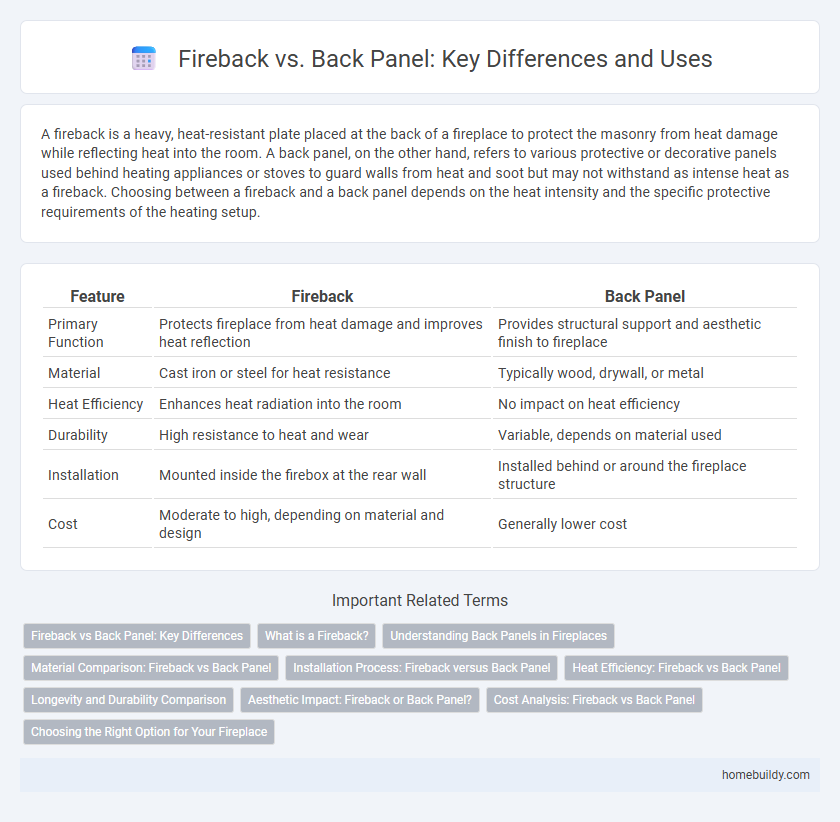A fireback is a heavy, heat-resistant plate placed at the back of a fireplace to protect the masonry from heat damage while reflecting heat into the room. A back panel, on the other hand, refers to various protective or decorative panels used behind heating appliances or stoves to guard walls from heat and soot but may not withstand as intense heat as a fireback. Choosing between a fireback and a back panel depends on the heat intensity and the specific protective requirements of the heating setup.
Table of Comparison
| Feature | Fireback | Back Panel |
|---|---|---|
| Primary Function | Protects fireplace from heat damage and improves heat reflection | Provides structural support and aesthetic finish to fireplace |
| Material | Cast iron or steel for heat resistance | Typically wood, drywall, or metal |
| Heat Efficiency | Enhances heat radiation into the room | No impact on heat efficiency |
| Durability | High resistance to heat and wear | Variable, depends on material used |
| Installation | Mounted inside the firebox at the rear wall | Installed behind or around the fireplace structure |
| Cost | Moderate to high, depending on material and design | Generally lower cost |
Fireback vs Back Panel: Key Differences
A fireback is a heavy, cast iron plate positioned at the back of a fireplace to protect the masonry and radiate heat into the room, enhancing warmth and energy efficiency. In contrast, a back panel refers to any material or structure installed behind the fireplace insert, primarily serving aesthetic purposes and basic protection but lacking the heat-retaining properties of a fireback. The key differences lie in the fireback's durability, heat conduction, and role in improving fireplace performance compared to the primarily decorative and protective function of standard back panels.
What is a Fireback?
A fireback is a cast iron panel installed at the back of a fireplace, designed to protect the masonry from intense heat and reflect warmth into the room. Unlike a simple back panel, a fireback enhances heat efficiency by radiating stored heat longer and shielding the fireplace structure. Its durable construction also allows it to withstand the high temperatures of a wood-burning fire, prolonging the life of the fireplace.
Understanding Back Panels in Fireplaces
Back panels in fireplaces serve as critical heat shields that protect walls from high temperatures while enhancing radiant heat efficiency. Firebacks, often made from cast iron, function as a specialized type of back panel by absorbing and reflecting heat into the room, boosting overall warmth output. Unlike standard back panels, firebacks also contribute aesthetic value with decorative designs, making them both functional and visually appealing.
Material Comparison: Fireback vs Back Panel
Firebacks are typically made of cast iron, offering superior heat retention and durability compared to back panels, which are often constructed from thinner sheet metal or less dense materials. The dense cast iron composition of firebacks not only radiates heat more efficiently into the room but also protects the fireplace masonry from intense heat damage. In contrast, back panels provide basic protection but lack the thermal mass and longevity that firebacks deliver in high-temperature environments.
Installation Process: Fireback versus Back Panel
Firebacks typically require a more straightforward installation, as they are designed to be placed directly against the fireplace wall, providing heat resistance and protection without extensive modifications. Back panels often involve a more complex setup, sometimes necessitating additional framing or mounting hardware to ensure proper alignment and stability within the fireplace structure. Choosing a fireback simplifies the installation process by minimizing the need for extra tools or materials compared to a back panel.
Heat Efficiency: Fireback vs Back Panel
Firebacks offer superior heat efficiency by absorbing and radiating heat back into the room, significantly enhancing stove or fireplace performance compared to standard back panels. Unlike conventional back panels that primarily serve as protective barriers, firebacks are made from cast iron or similar heat-retentive materials designed to store and release heat over time. This thermal mass effect results in increased room warmth and reduced fuel consumption, making firebacks a more energy-efficient choice.
Longevity and Durability Comparison
Firebacks are typically made from cast iron, offering superior longevity and durability compared to standard back panels, which are often constructed from thinner metal or refractory materials. The dense, heat-resistant cast iron in firebacks retains heat efficiently while providing robust protection against cracks and warping under high temperatures. Over time, firebacks demonstrate enhanced resistance to corrosion and mechanical wear, making them a more durable choice for long-lasting fireplace protection.
Aesthetic Impact: Fireback or Back Panel?
Firebacks create a visually striking focal point with intricate designs and rich materials that enhance the fireplace's aesthetic impact. Back panels offer a more subtle, functional backdrop, often made from plain or heat-resistant materials that emphasize practicality over decoration. Choosing a fireback elevates the fireplace's artistic appeal, while back panels prioritize minimalism and heat protection.
Cost Analysis: Fireback vs Back Panel
Firebacks typically cost more upfront than basic back panels due to their durable cast iron construction and intricate designs, providing enhanced heat reflection and fireplace protection. Basic back panels offer a lower initial price but may lack the effective heat distribution and longevity of firebacks, potentially leading to higher maintenance costs over time. When evaluating cost efficiency, firebacks deliver better long-term value through improved hearth performance and reduced wear on fireplace bricks.
Choosing the Right Option for Your Fireplace
Firebacks are designed to protect the masonry of your fireplace while maximizing heat reflection into the room, making them ideal for those seeking increased warmth and durability. Back panels, often made from heat-resistant materials like tempered glass or metal, primarily serve aesthetic purposes and help contain embers. Selecting between a fireback and a back panel depends on whether heat efficiency or decorative appeal is the priority for your fireplace setup.
Fireback vs Back Panel Infographic

 homebuildy.com
homebuildy.com